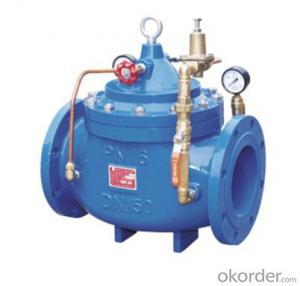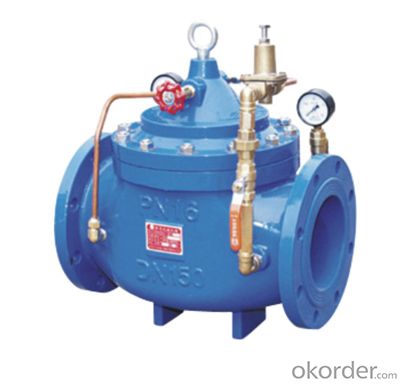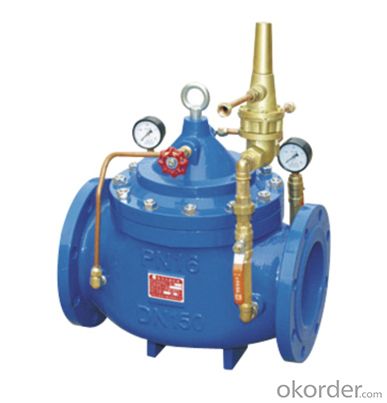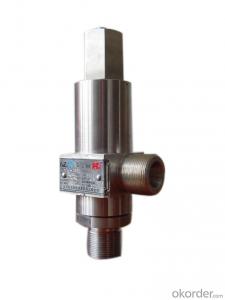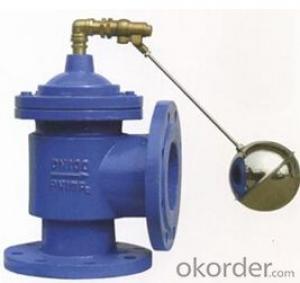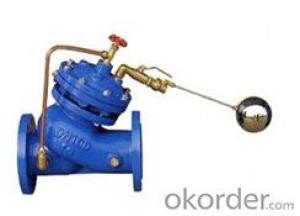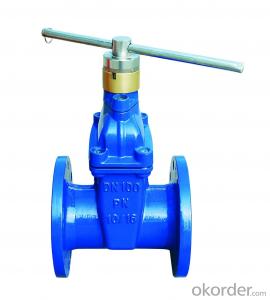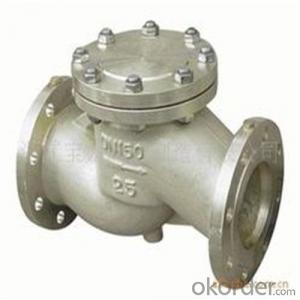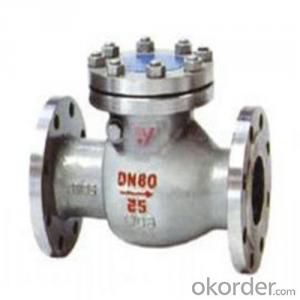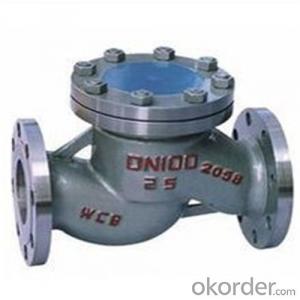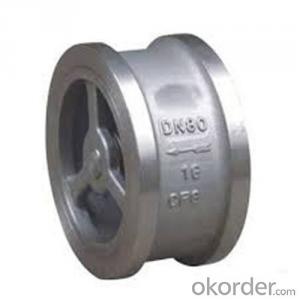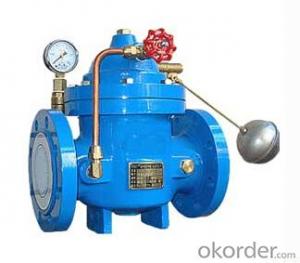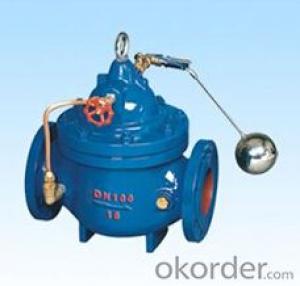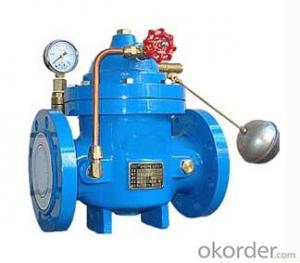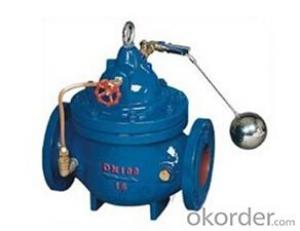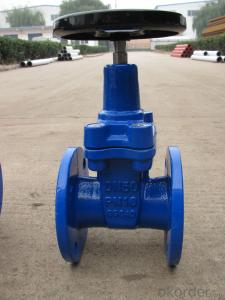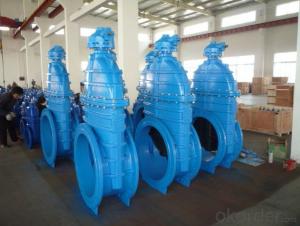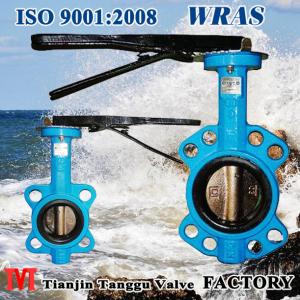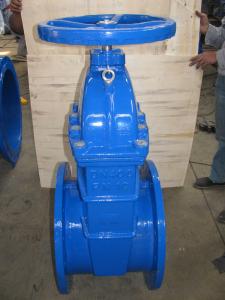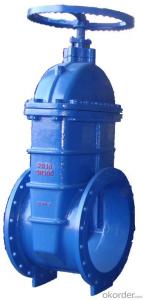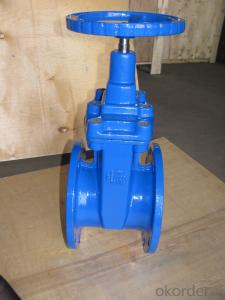DN250 Ductile Iron Remote control float valve BS Standard
- Loading Port:
- Tianjin
- Payment Terms:
- TT OR LC
- Min Order Qty:
- 1 set
- Supply Capability:
- 5000 set/month
OKorder Service Pledge
OKorder Financial Service
You Might Also Like


General valve using the market long-term, widespread Water Leakage, rust phenomenon, soft sealing gate valve produced by the introduction of foreign advanced technology of the enterprise. To overcome the poor sealing gate valve, general elastic fatigue, rust and other defects. Soft sealing gate valve is a traditional valve replacement products, the compensation effect of using flexible gate produce small deformation, achieve good sealing effect, the valve has a light switch, reliable sealing, good elastic memory and long service life and other significant advantages, can be widely used in water, sewage, construction, food, medicine, metallurgy, electric power, textile, energy systems, fluid pipeline regulation and closure devices as.
The characteristics of:
- flat style seat
The traditional control valve often pass after washing due to foreign objects such as stone, wood, cement, paper, and other debris deposited on the valve at the end of the groove. Close but not close easily lead to the formation of Water Leakage phenomenon, the lower part of the soft sealing gate valve with water using the same flat design, easy to siltation caused by debris, the fluid unimpeded.
And the overall package glue
The valve plate is made of high-quality rubber overall, the outsourcing of plastic, making the domestic first-class rubber vulcanization vulcanization after the valve plate to ensure accurate geometry, and the rubber and ductile iron gate is connected firmly, not easy to fall off and good elastic memory.
And corrosion resistance
The valve body adopts epoxy coating powder, can prevent the corrosion and rust, and can be used for sewage systems.
And not easy to break
Traditional cast iron garden gate often hit foreign objects, collision or overlap caused by the fracture phenomenon. Because the valve to switch to ductile iron, this is the case already significantly reduced.
Three "O" ring seal
As the valve stem with three "0" ring ring seal design, can reduce friction when the switch is greatly reduced, Water Leakage phenomenon and can cut off the water supply construction not replace sealing ring.
And help to drink
Due to the internal body to non-toxic epoxy resin coating, gate of the inner and outer surfaces are completely coated with rubber and can not rust or corrosion of water available to drink.
- Casting valve
Valve body casting, precise geometry makes the body without any internal finishing to ensure that the valve seal.
And light weight
The valve is made of ductile cast, lighter in weight than conventional gate weight about 20%-30%. Convenient installation and repair.
Overview:
General valve using the market long-term, widespread Water Leakage, rust phenomenon, soft sealing gate valve produced by the introduction of foreign advanced technology of the enterprise. To overcome the poor sealing gate valve, general elastic fatigue, rust and other defects. Soft sealing gate valve is a traditional valve replacement products, the compensation effect of using flexible gate produce small deformation, achieve good sealing effect, the valve has a light switch, reliable sealing, good elastic memory and long service life and other significant advantages, can be widely used in water, sewage, construction, food, medicine, metallurgy, electric power, textile, energy systems, fluid pipeline regulation and closure devices as.
The characteristics of:
- flat style seat
The traditional control valve often pass after washing due to foreign objects such as stone, wood, cement, paper, and other debris deposited on the valve at the end of the groove. Close but not close easily lead to the formation of Water Leakage phenomenon, the lower part of the soft sealing gate valve with water using the same flat design, easy to siltation caused by debris, the fluid unimpeded.
And the overall package glue
The valve plate is made of high-quality rubber overall, the outsourcing of plastic, making the domestic first-class rubber vulcanization vulcanization after the valve plate to ensure accurate geometry, and the rubber and ductile iron gate is connected firmly, not easy to fall off and good elastic memory.
And corrosion resistance
The valve body adopts epoxy coating powder, can prevent the corrosion and rust, and can be used for sewage systems.
And not easy to break
Traditional cast iron garden gate often hit foreign objects, collision or overlap caused by the fracture phenomenon. Because the valve to switch to ductile iron, this is the case already significantly reduced.
Three "O" ring seal
As the valve stem with three "0" ring ring seal design, can reduce friction when the switch is greatly reduced, Water Leakage phenomenon and can cut off the water supply construction not replace sealing ring.
And help to drink
Due to the internal body to non-toxic epoxy resin coating, gate of the inner and outer surfaces are completely coated with rubber and can not rust or corrosion of water available to drink.
- Casting valve
Valve body casting, precise geometry makes the body without any internal finishing to ensure that the valve seal.
And light weight
The valve is made of ductile cast, lighter in weight than conventional gate weight about 20%-30%. Convenient installation and repair.


- Q: Surly Pilots don't just switch the fuel selector valve of mid flight
- Not to take away from JFK jr's piloting skills but the possibility exists that he failed to check to see if the fuel valve was on in the first place. I do not know how far along in the flight he was, but a typical piston engine plane can get you up and on your way with the fuel that is in the fuel system. Why I know this, my flight instructor while training one of his students died in a forced landing due to engine failure because the fuel valve was not turned on. My flight instructor would allow his students to perform the preflight on there on, of course after many hours of dual training. The plane was a piper four place, it made it to about 400 feet agl before the engine stalled from fuel starvation. The irony of his death was from complications on the operating table from a broken ankle and a blood clot that broke loose. Checking for the on position of the fuel valve is on the check list. During emergency landing procedures, one of the functions is to turn the fuel valve off to reduce the possibily of fire. This doesn't answer the question but is a possibility unless of course he was well into his flight before the accident, in which case he probably moved the fuel valve to the off position following emergency procedures.
- Q: We have an ejector in the basement for an in-law apartment. When the check valve kicks in, it can wake us up from a sound sleep. A very loud thunking. Any ideas?
- the check valve would be installed just outside of the crock vertically. The noise I doubt is from the check valve itself. I'd guess it is the pump shutting off and the pipe isn't fastened securely, so it bangs. Check to make sure that the run of pipe leaving the crock is fastened securely. if this is the case the only other option I oculd think of would be to re-position the check valve on a horizontal run of pipe as close to the crock as possible. Most check valves I have seen for ejectors are compression type, it will be messy but not to complicated. Keep a bucket handy, when you crack open that check valve you may need it. Flush the toilet until the pump kicks on a few times, this should clear out most of the nasty stuff. You may also need a short piece of 2 pipe and some couplings to make up for the space of the check valve. If you can hear the water flowing out when the pump kicks on and don't hear it draining back into the crock when it shuts off, the check valve is probably still good.
- Q: school starts tomorrow that means having band and i havent played it in 2 months (summer vacation) and i oiled the valves and the 1 and 2 valves are stuck the 1st valve comes up slowly when i push it down but on the 2nd valve it stays down how do i undo this???? thank you
- You could just get a screwdriver and drill it into the bottom of the valve till it comes out. Its not damaging anything because there are no air pipes going through the bottom .
- Q: How many valves are involved in th etypical 4-stroke cycle? Is it the intake and exhaust valves only? If my car engine has 12 valves, how many cylinders does it have?
- nowadays usually it's four valves per cylinder, though still u may find 2 valves per cylinder. u cann't know how many cylinders u have from knowing the number of valves, it depends on the design.
- Q: The atrioventricular valves will be open whenA. Atria are in diastole and ventricles are in systole B. Pressure in the ventricles is greater than the pressure in the great arteries C. The ventricles are being passively filled D. The ventricles are in isovolumetric contraction
- Answer: (c) The ventricles are being passively filled. During diastole, a normally-functioning mitral valve opens as a result of increased pressure from the left atrium as it fills with blood (preloading). As atrial pressure increases above that of the left ventricle, the mitral valve opens. Opening facilitates the passive flow of blood into the left ventricle. Diastole ends with atrial contraction, which ejects the final 20% of blood that is transferred from the left atrium to the left ventricle. This amount of blood is known as end diastolic volume (EDV), and the mitral valve closes at the end of atrial contraction to prevent a reversal of blood flow. Mitral valve also opens when right ventricle is passively filled.
- Q: Hi, I'd like to control a three way solenoid valve like this one:understanding is that an electric current through the solenoid will cause the valve to let air one way while no electric current will have the air flow the other. Is there a piece of equipment like a control box (that can communicate w/ a computer) that would allow me to control the solenoid valve like this? and if so, where would i be able to find something like this....i've googled but no success. I eventually want to control the valve from a computer. Thanks
- There are dozens of valves on that link, you have to be more specific. Most valves switch between open/close with application / removal of electrical power. Restricting air flow to one direction is done via a check valve, not something that requires power. Air flow will be from the direction of higher pressure to lower pressure. A valve can stop that flow, it cannot reverse it. You can control the valve with a relay, and that with relay driver IC such as a ULN2003, and that driven by a computer. Depending on the power levels, you may be able to drive the relay directly from the relay driver. .
- Q: My husband just found out that one of the heart valves is 100% blocked and the other 3 are 90% or more blocked . He is 78 years old he Is nearly non mobile. What kind of treatment would you suggest?
- A heart valve can't be 100% blocked. The heart simply couldn't function. On the other hand, coronary arteries can be blocked as you described. Normally, 4 vessel disease is treated with bypass surgery. In a high risk patient, angioplasty might be an option. However, if he is not having cardiac symptoms , or if he is thought to be TOO high risk, the option is medical treatment. Sit down for a talk with his cardiologist.
- Q: Well I had a Anginogram that said I have Mitral Valve Stenosis with the LVEDP was Moderately Elevated and My Right Ventricular Moderately Elevated and My Right Atruim is Moderately Elevated what do all this mean I see my cardiologists in two weeks to go over things. Oh yes they don't say how much the Mitral Valve is narrow.
- Mitral stenosis (MS) is narrowing of the mitral orifice impeding blood flow from the left atrium to the left ventricle. The (almost) invariable cause is rheumatic fever. Common complications are pulmonary hypertension, atrial fibrillation, and thromboembolism. Symptoms are those of heart failure; signs include an opening snap and a diastolic murmur. Diagnosis is by physical examination and echocardiography. Prognosis is good. Medical treatment includes diuretics, β-blockers or rate-limiting Ca channel blockers, and anticoagulants; effective treatment for more severe disease consists of balloon valvotomy, surgical commissurotomy, or valve replacement. The normal area of the mitral valve orifice is about 4 to 6 cm2. Under normal conditions, a normal mitral valve will not impede the flow of blood from the left atrium to the left ventricle during (ventricular) diastole, and the pressures in the left atrium and the left ventricle during diastole will be equal. The result is that the left ventricle gets filled with blood during early diastole, with only a small portion of extra blood contributed by contraction of the left atrium (the atrial kick) during late ventricular diastole. Patients with mitral stenosis prompts a series of hemodynamic changes that frequently cause deterioration of the patient's clinical status. A reduction in cardiac output, associated with acceleration of heart rate and shortening of the diastolic time, frequently leads to congestive heart failure. In addition, when AF sets in, systemic embolization becomes a real danger. Please undergo echocardiography test and check whether you have other heart defects such as mitral regurgitation and aortic insufficiency.
- Q: right after it come through the foundation. Should it be a gate valve?
- Main shut off of what? Water or gas?
- Q: One day i was cleaning my trumpet's third valve. when i tried pressing the key it was goig inok but near the end it gets stuck and gets unstuck like a second later.how can i fix this problem with out spending too much money?
- instead of the standard cheapo trumpet grease, try a more generic brass instrument oil. also make sure you aren't tightening the valve screw cap too tightly. it's not a good idea just keep tapping it. also, unwanted moisture can create a seal that will sometimes inhibit the valve from popping back up. get it dried out as much as you can. also, don't use too much of anything - the oil, the grease, etc - excess will keep it from popping out too.
Send your message to us
DN250 Ductile Iron Remote control float valve BS Standard
- Loading Port:
- Tianjin
- Payment Terms:
- TT OR LC
- Min Order Qty:
- 1 set
- Supply Capability:
- 5000 set/month
OKorder Service Pledge
OKorder Financial Service
Similar products
Hot products
Hot Searches
Related keywords
